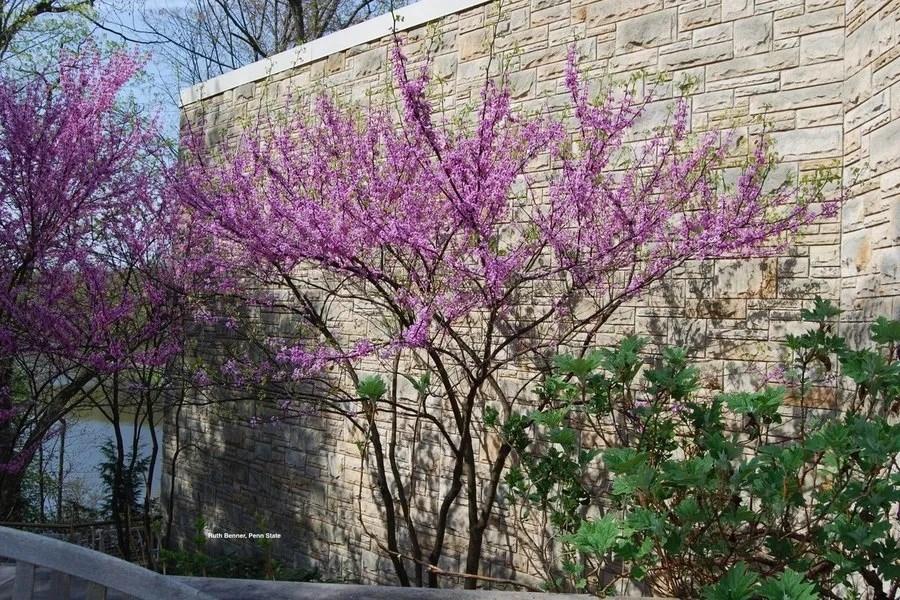
2 minute read
Eastern Redbud: A Superb Tree for Almost Any Landscape
By Sandy Feather, PennState Extension Educator, Green Industry
Cultivars include
Advertisement
• 'Ace of Hearts' - The shiny green leaves are about half the size of the species, and overlap, giving them a ranked appearance on the branches. 'Ace of Hearts' grows about half the size of the species.
• 'Alba' - Blooms with white flowers, but otherwise similar to the species.
• 'Covey' (Lavender Twist™) - A weeping form with stiff, contorted branches.
• 'Forest Pansy' - The new growth emerges a vibrant burgundy color, and flowers are purpler than the straight species. Leaves harden off to green as they mature.
• 'Hearts of Gold' - New growth emerges yellow tinged with red, then matures yellow to green.
• 'Silver Cloud' - The foliage is variegated with irregular white splotches. Does not flower as heavily as the straight species. Protect from hot afternoon sun.
• The Rising Sun™ - The new growth emerges goldenorange, matures to yellow, and hardens off to green.
Eastern redbud (Cercis canadensis) is small, graceful tree native to the eastern and central United States.
It is typically found in open woodlands, thickets, woodland margins, and along streams and bluffs, often on limestone soils. It blooms before and as the leaves emerge, with rosy-pink, pea-like flowers that are borne in fascicles of four to eight. The flowers are held close to the branches, and even bloom along the trunks, clothing almost every inch in bloom. Trees may be trained to a single trunk or grow multi-stemmed. Eastern redbud has a flat-topped to rounded growth habit, and large heart-shaped leaves.
Fall foliage color is variable, but can be a good, clear yellow. Eastern redbud is in the Fabaceae (legume) family, so the fruits are brown to black pods typical of that family. While most members of the legume family are able to fix nitrogen from the atmosphere, eastern redbud lacks the nodules and bacteria necessary for that process.
Eastern redbud grows 20-30 feet tall and 25-35 feet wide, making it a suitable choice for small landscapes. It grows best in full sun to part shade and evenly moist, welldrained soils, but is adaptable to most soils as long as drainage is good. It is also tolerant of acid or alkaline soils. Eastern redbud is hardy in USDA Zones 4-9.
Use as a specimen, patio or lawn tree, in small groups or naturalized plantings. Eastern redbud is excellent with spring-flowering bulbs such as daffodils and tulips that are in bloom at the same time.
Safety Tips for Farm and Garden
• Warm up. Farming and gardening involve a lot of physical labor. This can be hard on your body. It is important to first warm up and stretch your muscles. This will help prevent injuries.
• Choose tools wisely. The tools you use can help reduce the amount of stress you put on your body. Choose ergonomic tools that minimize this stress. Keep sharp tools away from children and animals. Keep electrical cords, ropes and hoses out of walkways.
• Focus on your posture. Chores on a farm often include a lot of bending and kneeling. Heavy jobs can cause injuries if not conducted properly with the right posture. Take the time to ensure you maintain the right posture. You should never feel uncomfortable. Instead of bending over, kneel using knee pads when possible. Avoid “solo” jobs that involve very heavy lifting. When possible, use equipment to do the heavy lifting or have another person help you.
• Drink water often. Drinking water is critical to your health and productivity. As the days get longer and hotter, you are at increased risk for dehydration.
• Take a short break. Farming and gardening are hard work. Remember to take breaks often. As the days get longer and hotter, take more breaks. This will greatly improve your ability to work.






